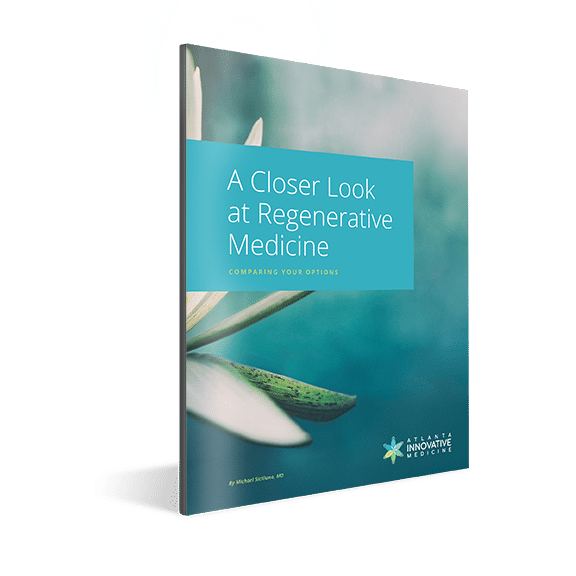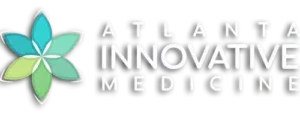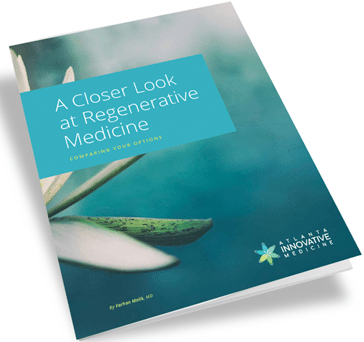By Farhan Malik, MD
Atlanta Innovative Medicine
Back pain is one of the most common medical problems that people experience worldwide. In fact, up to 80% of the population will experience back pain at some point in their lives. Unfortunately, many people who suffer from back pain are also misdiagnosed which makes treating back pain very difficult.
A misdiagnosis can lead to prolonged discomfort and potentially serious health problems. For this reason, when treating back pain, it is crucial to understand the causes, know the related symptoms, and seek high-quality care from attentive specialists.
What causes back pain?
Back pain can be caused by injuries, like strains or sprains, or by a wide variety of health or lifestyle factors, including disc-related issues, pinched nerves, arthritis, poor posture, issues elsewhere in the body that lead to misalignment, and numerous others.
Why is back pain often misdiagnosed?
Misdiagnosis is common when it comes to back pain because there are so many potential causes and because the various back pain causes can look much the same. In many cases, there are multiple issues at play, and the one that seems immediately obvious, in an X-ray, for example, may not be the true source of pain.

What are the most frequently misdiagnosed causes of back pain?
Some of the most commonly misdiagnosed causes of back pain are sacroiliac joint pain, degenerative disc disease, and a herniated lumbar disc.
Sacroiliac joint pain
The sacroiliac joint is located where the base of the spine (the sacrum) meets the pelvis. Sacroiliac joint pain occurs when there is inflammation around or damage to this joint.
What does sacroiliac joint pain feel like?
Symptoms of sacroiliac joint pain include:
- Dull, aching lower back pain
- Pain that spreads to the groin and legs
- Inflammation in the legs
- Sciatic-type nerve pain
Treating back pain in the sacroiliac joint
With a proper diagnosis, sacroiliac joint pain relief can be achieved through anti-inflammatory injections at the source, targeted chiropractic adjustments, physical therapy, or regenerative treatments that promote healing at the point of damage.
Degenerative disc disease
Between the spine’s vertebrae are soft, flexible discs that absorb shock and enable movement. When these discs wear with age or become injured, the damage is referred to as degenerative disc disease.
What does degenerative disc disease feel like?
Some of the most common symptoms of degenerative disc disease include:
- Pain that worsens when sitting
- Pain that eases when walking or changing positions
- Numbness or tingling in the extremities
- Leg muscle weakness
- Foot drop
- Sciatica
Treating back pain from degenerative disc disease
Treating back pain caused by degenerative disc disease often involves physical therapy, regenerative treatments, and pain relief injections. When degenerative disc disease is properly diagnosed, relief is very much possible.
Herniated lumbar disc
A herniated lumbar disc is a herniated disc in the lower spine. When injured or worn down with age, the inner portion of a disc can start to protrude and press on the spinal nerves, resulting in irritation of the nerve roots called lumbar radiculopathy.
What does a herniated disc feel like?
When a herniated lumbar disc causes lumbar radiculopathy, sciatica typically results. Sciatica pain can feel like:
- Dull aching
- Burning
- Sharp stabbing
- Numbness and tingling
- Muscle weakness
Treating back pain from a herniated lumbar disc
When a herniated disc has been diagnosed, the resulting pain can be effectively treated in a number of ways. Treating back pain from a herniated disc can involve a tailored combination of physical therapy, chiropractic care, and noninvasive regenerative treatments.
The location and type of back pain plays a significant role in diagnosing the cause. Because sacroiliac joint pain, degenerative disc disease, and a herniated lumbar disc are all marked by sciatic-type pain and the related sensations, misdiagnosis of these conditions is very common.

What are the other causes of back pain?
Strains & sprains
Strains and sprains occur when you injure or overstretch the ligaments, tendons or muscles that support your spine. This can result from sudden movements, a fall or other trauma, muscle overuse, or incorrectly lifting heavy objects. They can cause painful muscle spasms, swelling, stiffness, and limited mobility.
Disc issues & pinched nerves
Beyond degenerative disc disease and herniated discs, there are several other disc and nerve issues that can cause back pain, including torn discs, which occur when the outer layer of a disc tears and the inner material begins to leak out, and spinal stenosis, which occurs when the spaces of the spinal column shrink, putting pressure on the spinal cord and the surrounding nerves.
Fractures
A fracture refers to a crack or break in the vertebrae, typically caused by trauma such as a fall or accident, or by underlying conditions like osteoporosis which weakens the bones. Fractures vary in extremity; minor fractures are not always immediately noticeable and can be mistaken for muscle strains or sprains.
Lifestyle factors
Poor posture, such as slouching or hunching over a desk, and excess body weight can both put extra strain on the back muscles and spine. Additionally, a sedentary lifestyle that involves prolonged sitting or lack of exercise can weaken the muscles supporting the spine, causing pain and making one more prone to injury.
Underlying conditions
Osteoarthritis, a degenerative joint disease, can cause swelling, stiffness, and pain in the spine as well as in other joints throughout the body, which can in turn cause back pain. Osteoporosis, the loss of bone density, weakens the bones and increases the risk of fractures. These are some of the most common conditions that can cause or exacerbate back pain, but there are numerous others, including fibromyalgia, ankylosing spondylitis, and scoliosis.

Subscribe for Expert Insights and Our Ebook
A Closer Look at Regenerative Medicine: Comparing Your Options Learn about treatment options like Platelet Rich Plasma (PRP), Prolozone Therapy, and Stem Cell Therapy.
Treating back pain
To effectively treat back pain, it is essential to begin with an accurate diagnosis. Because of the quantity and complexity of back pain causes, a proper diagnosis cannot rely on any one test, any isolated count of pain, or any singular symptom, like sciatica alone. Instead, it should come from a combination of tests, such as nerve conduction velocity testing, imaging, and comprehensive questions with expansive attention to pain patterns.
With the right diagnosis, a series of non-surgical methods can be used to effectively treat the root of back pain for more effective and longer-lasting healing and relief.
Treating back pain with nonsurgical orthopedic care
Non-surgical orthopedic care can include the use of braces and orthotics to provide support and stability to the affected area, as well as sarapin injections to reduce inflammation or numb the nerves to alleviate pain. These methods can often provide relief from back pain without the need for more involved or invasive treatments.
What are sarapin injections?
Sarapin is an FDA-approved injectable analgesic that can help with muscular or neuropathic back pain by blocking pain signals to your backbone. Unlike similar medications, it does not affect other nerves or motor functions—nor is it associated with any significant side effects—making it particularly effective for people with chronic back pain for which other medications have had no positive effect.
Treating back pain with chiropractic care
The spine consists of 24 vertebrae that work together to facilitate movements. If any of these vertebrae are not aligned correctly—which can result from a wide range of conditions, injuries, or lifestyle factors—movement can become difficult and painful. By manipulating the spine and joints to correct alignment issues, improve range of motion, and increase blood circulation to the affected areas, chiropractic care offers a noninvasive approach to correcting the root issue, and as such, it is often one of the first methods for treating back pain.
Treating back pain with regenerative medicine
Regenerative medicine refers to a variety of treatments that use the body’s natural healing processes to promote tissue repair and regeneration. Regenerative medicine is safe, natural, and noninvasive, making it a safe means of treating back pain, even when the cause of pain is not certain. At Atlanta Innovative Medicine, we often use one or a combination of the following treatments to heal and relieve back pain:
- Platelet-rich plasma therapy (PRP) involves the injection of concentrated platelets from the patient’s own blood to stimulate healing and reduce inflammation.
- Prolozone therapy involves the injection of a combination of procaine, nutrients, and collagen to reduce inflammation, and ozone to promote tissue regeneration.
- Prolotherapy involves the injection of a natural irritant to stimulate the body’s healing response and activate the body’s fibroblasts, cells that help form connective tissues.
- Hemozone therapy combines PRP and ozone injections to both aid ligament repair and relieve pain.
Treating back pain with stem cell therapy
Adipose (or fat) tissue contains a large amount of stem cells, cytokines, exosomes, and other growth factors that enable the body’s cellular repair and regeneration. Adipose stem cell therapy involves the collection of this fat (via minimally invasive liposuction), the concentration of its regenerative elements, and the redistribution of the concentration into the damaged area of the body. Treating back pain with stem cell therapy can be highly effective as it allows natural healing of the source of pain—whether that’s in the back itself or somewhere else in the body.

Treating back pain at Atlanta Innovative Medicine
Quizzes
Are you a candidate for Regenerative Medicine?
Regenerative medicine can be an effective therapy and treatment option for lasting pain relief for a variety of conditions like osteoarthritis of the knee, hip or shoulder; ACL or meniscus tears; tennis or golfer’s elbow; chronic neck and back pain; and more.
Is it right for you and your condition? Take 1 minute to answer a few “yes or no” questions that help to assess if you might be a candidate for PRP, stem cell or other nonsurgical regenerative treatments.
Are You a Stem Cell Candidate for Your Joint or Spine Damage?
Are you a candidate for Platelet Rich Plasma (PRP) Therapy?
Do I have nonsurgical options for my injured or aging joints?
Take the Pain Medications Risk Quiz

Regenerative Medicine.
Reimagined
- Advanced hybrid therapies, including Mesenchymal Stem Cell therapy combined with different mechanisms of action that synergistically come together to support ultimate healing
- More powerful PRP that’s customized, amplified and personalized
- Therapies delivered by an experienced, compassionate team comprised of multidisciplinary experts in traditional and alternative medicine working as your team: Medical Doctors, Nurse Practitioners, Physiotherapists and Chiropractors
- Advanced training through the American Academy of Orthopedic Medicine, the American Osteopathic Association of Prolotherapy Regenerative Medicine, and more
All content of this page is for informational purposes only and is not intended to serve as a substitute for the consultation, diagnosis, and/or medical treatment of a qualified physician or healthcare provider. Individual results may vary. Your medical professional can explain all the risks and potential benefits of any therapy based on your specific circumstances. At this time regenerative therapies are not FDA approved. Neither Atlanta Innovative Medicine nor its physician affiliates promise regenerative therapies as a cure for any condition, disease, or injury.
Other Atlanta Areas We Service:
© 2024 Atlanta Innovative Medicine, LLC. All Rights Reserved. AIM Scholarship Opportunity








